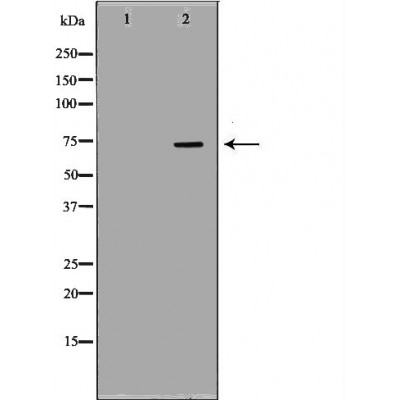APLP1 Antibody - #DF7047
| Product: | APLP1 Antibody |
| Catalog: | DF7047 |
| Description: | Rabbit polyclonal antibody to APLP1 |
| Application: | WB IHC |
| Reactivity: | Human, Mouse, Rat |
| Prediction: | Pig, Bovine, Horse, Sheep, Dog |
| Mol.Wt.: | 72kD; 72kD(Calculated). |
| Uniprot: | P51693 |
| RRID: | AB_2839003 |
Related Downloads
Protocols
Product Info
*The optimal dilutions should be determined by the end user. For optimal experimental results, antibody reuse is not recommended.
*Tips:
WB: For western blot detection of denatured protein samples. IHC: For immunohistochemical detection of paraffin sections (IHC-p) or frozen sections (IHC-f) of tissue samples. IF/ICC: For immunofluorescence detection of cell samples. ELISA(peptide): For ELISA detection of antigenic peptide.
Cite Format: Affinity Biosciences Cat# DF7047, RRID:AB_2839003.
Fold/Unfold
AMYLOID BETA A4 PRECURSOR-LIKE PROTEIN 1; AMYLOID PRECURSOR-LIKE PROTEIN; Amyloid-like protein 1 precursor; APLP 1; APLP; APLP-1; Aplp1; APLP1_HUMAN; C30;
Immunogens
A synthesized peptide derived from human APLP1, corresponding to a region within the internal amino acids.
Expressed in the cerebral cortex where it is localized to the postsynaptic density (PSD).
- P51693 APLP1_HUMAN:
- Protein BLAST With
- NCBI/
- ExPASy/
- Uniprot
MGPASPAARGLSRRPGQPPLPLLLPLLLLLLRAQPAIGSLAGGSPGAAEAPGSAQVAGLCGRLTLHRDLRTGRWEPDPQRSRRCLRDPQRVLEYCRQMYPELQIARVEQATQAIPMERWCGGSRSGSCAHPHHQVVPFRCLPGEFVSEALLVPEGCRFLHQERMDQCESSTRRHQEAQEACSSQGLILHGSGMLLPCGSDRFRGVEYVCCPPPGTPDPSGTAVGDPSTRSWPPGSRVEGAEDEEEEESFPQPVDDYFVEPPQAEEEEETVPPPSSHTLAVVGKVTPTPRPTDGVDIYFGMPGEISEHEGFLRAKMDLEERRMRQINEVMREWAMADNQSKNLPKADRQALNEHFQSILQTLEEQVSGERQRLVETHATRVIALINDQRRAALEGFLAALQADPPQAERVLLALRRYLRAEQKEQRHTLRHYQHVAAVDPEKAQQMRFQVHTHLQVIEERVNQSLGLLDQNPHLAQELRPQIQELLHSEHLGPSELEAPAPGGSSEDKGGLQPPDSKDDTPMTLPKGSTEQDAASPEKEKMNPLEQYERKVNASVPRGFPFHSSEIQRDELAPAGTGVSREAVSGLLIMGAGGGSLIVLSMLLLRRKKPYGAISHGVVEVDPMLTLEEQQLRELQRHGYENPTYRFLEERP
Predictions
Score>80(red) has high confidence and is suggested to be used for WB detection. *The prediction model is mainly based on the alignment of immunogen sequences, the results are for reference only, not as the basis of quality assurance.
High(score>80) Medium(80>score>50) Low(score<50) No confidence
Research Backgrounds
May play a role in postsynaptic function. The C-terminal gamma-secretase processed fragment, ALID1, activates transcription activation through APBB1 (Fe65) binding (By similarity). Couples to JIP signal transduction through C-terminal binding. May interact with cellular G-protein signaling pathways. Can regulate neurite outgrowth through binding to components of the extracellular matrix such as heparin and collagen I.
The gamma-CTF peptide, C30, is a potent enhancer of neuronal apoptosis.
Proteolytically cleaved by caspases during neuronal apoptosis. Cleaved, in vitro, at Asp-620 by caspase-3 (By similarity).
N- and O-glycosylated. O-glycosylation with core 1 or possibly core 8 glycans. Glycosylation on Ser-227 is the preferred site to Thr-228.
Cell membrane>Single-pass type I membrane protein.
Cytoplasm.
Note: C-terminally processed in the Golgi complex.
Expressed in the cerebral cortex where it is localized to the postsynaptic density (PSD).
The NPXY sequence motif found in many tyrosine-phosphorylated proteins is required for the specific binding of the PID domain. However, additional amino acids either N- or C-terminal to the NPXY motif are often required for complete interaction. The NPXY site is also involved in clathrin-mediated endocytosis.
Belongs to the APP family.
Restrictive clause
Affinity Biosciences tests all products strictly. Citations are provided as a resource for additional applications that have not been validated by Affinity Biosciences. Please choose the appropriate format for each application and consult Materials and Methods sections for additional details about the use of any product in these publications.
For Research Use Only.
Not for use in diagnostic or therapeutic procedures. Not for resale. Not for distribution without written consent. Affinity Biosciences will not be held responsible for patent infringement or other violations that may occur with the use of our products. Affinity Biosciences, Affinity Biosciences Logo and all other trademarks are the property of Affinity Biosciences LTD.



